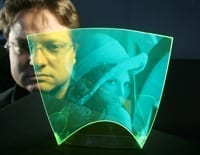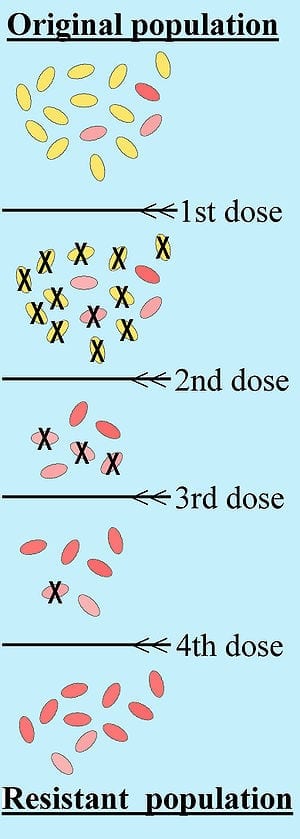
Fluorescent light traveling through polymer sheet may lead to user interface devices that respond to gestures alone
Digital cameras, medical scanners, and other imaging technologies have advanced considerably during the past decade. Continuing this pace of innovation, an Austrian research team has developed an entirely new way of capturing images based on a flat, flexible, transparent, and potentially disposable polymer sheet. The team describes their new device and its possible applications in a paper published today in the Optical Society’s (OSA) open-access journal Optics Express.
The new imager, which resembles a flexible plastic film, uses fluorescent particles to capture incoming light and channel a portion of it to an array of sensors framing the sheet. With no electronics or internal components, the imager’s elegant design makes it ideal for a new breed of imaging technologies, including user interface devices that can respond not to a touch, but merely to a simple gesture.
“To our knowledge, we are the first to present an image sensor that is fully transparent – no integrated microstructures, such as circuits – and is flexible and scalable at the same time,” says Oliver Bimber of the Johannes Kepler University Linz in Austria, co-author of the Optics Express paper.
The sensor is based on a polymer film known as a luminescent concentrator (LC), which is suffused with tiny fluorescent particles that absorb a very specific wavelength (blue light for example) and then reemit it at a longer wavelength (green light for example). Some of the reemitted fluorescent light is scattered out of the imager, but a portion of it travels throughout the interior of the film to the outer edges, where arrays of optical sensors (similar to 1-D pinhole cameras) capture the light. A computer then combines the signals to create a gray-scale image. “With fluorescence, a portion of the light that is reemitted actually stays inside the film,” says Bimber. “This is the basic principle of our sensor.”
For the luminescent concentrator to work as an imager, Bimber and his colleagues had to determine precisely where light was falling across the entire surface of the film. This was the major technical challenge because the polymer sheet cannot be divided into individual pixels like the CCD camera inside a smartphone. Instead, fluorescent light from all points across its surface travels to all the edge sensors. Calculating where each bit of light entered the imager would be like determining where along a subway line a passenger got on after the train reached its final destination and all the passengers exited at once.
The solution came from the phenomenon of light attenuation, or dimming, as it travels through the polymer. The longer it travels, the dimmer it becomes. So by measuring the relative brightness of light reaching the sensor array, it was possible to calculate where the light entered the film. This same principle has already been employed in an input device that tracks the location of a single laser point on a screen.
The researchers were able to scale up this basic principle by measuring how much light arrives from every direction at each position on the image sensor at the film’s edge. They could then reconstruct the image by using a technique similar to X-ray computed tomography, more commonly known as a CT scan.
“In CT technology, it’s impossible to reconstruct an image from a single measurement of X-ray attenuation along one scanning direction alone,” says Bimber. “With a multiple of these measurements taken at different positions and directions, however, this becomes possible. Our system works in the same way, but where CT uses X-rays, our technique uses visible light.”
The Latest Bing News on:
Imaging device
- Organic infrared photodetectors offer advance in imaging technologyon May 9, 2024 at 12:08 pm
The demand for high pixel-count, low-cost focal-plane arrays in the near-infrared (NIR) and short-wavelength infrared (SWIR) spectra has surged due to their potential applications in AI-driven ...
- Veterinary Imaging Market Size Projected to Reach USD 4,306.6 Million by 2034: Future Market Insights, Inc.on May 9, 2024 at 7:35 am
The veterinary imaging market has been gaining significant traction globally, with a projected value of USD 2,272.8 million in 2024 and ...
- vivo and Zeiss forge new R&D partnership for Imaging solutionson May 8, 2024 at 10:03 pm
vivo and Zeiss have signed a new agreement to extend their joint research and development efforts. This collaboration aims to push the boundaries of cooperation further and foster sustainable ...
- Low-cost MRI Paired With AI Produces High-quality Resultson May 8, 2024 at 5:00 pm
A magnetic resonance imaging device built with off-the-shelf parts and paired with AI matched the performance of high-end MRI machines, according to a study published Thursday that could pave the way ...
- QT Imaging Holdings Announces Partnership with Premier Cancer Center, The Vincere Cancer Center in Scottsdale, AZon May 8, 2024 at 5:31 am
QT Imaging Holdings, Inc. (NASDAQ:QTI) ("QT Imaging") a medical device company engaged in research, development, and commercialization of innovative body imaging systems, together with its strategic ...
- FDA Approves First Fully Autonomous Handheld AI device for Diabetic Retinopathy Screeningon May 3, 2024 at 7:00 pm
AEYE Health, the leading company for AI retinal imaging and diagnostics, is thrilled to announce that it received the first ever FDA clearance for a fully autonomous AI that diagnoses ...
- Future Market Insights Positioned for Growth as Veterinary Imaging Market Surges to achieve a valuation of US$ 3.37 Billion by 2030on May 2, 2024 at 7:50 pm
The global veterinary imaging market is primed for significant expansion in the coming years, with a projected Compound Annual Growth Rate (CAGR) of 6.6% from 2022 to 2030, according to the latest ...
- Pleora brings GigE Vision software connectivity to wider range of cameras, sensors and embedded devices with expanded eBUS Edge platformon May 1, 2024 at 5:17 am
Pleora Technologies is expanding its eBUS Edge GigE Vision software transmitter solution with feature-based licensing tiers to help designers meet performance and cost demands as new 3D cameras, ...
- Indian medical sector works to strengthen capabilities in laser-based imaging deviceson April 29, 2024 at 7:30 pm
Indian medical sector works to strengthen capabilities in laser-based imaging devices: Nandita Vijayasimha, Bengaluru Tuesday, April 30, 2024, 08:00 Hrs [IST] Indian medical secto ...
- 'Seeing the invisible': New tech enables deep tissue imaging during surgeryon April 29, 2024 at 5:45 pm
Hyperspectral imaging (HSI) is a state-of-the-art imaging technique useful for determining the composition of a variety of objects. Specifically, over-thousand-nanometer (OTN) HSI is particularly ...
The Latest Google Headlines on:
Imaging device
[google_news title=”” keyword=”imaging device” num_posts=”10″ blurb_length=”0″ show_thumb=”left”] [/vc_column_text]The Latest Bing News on:
Image sensor
- Image Sensor Market Size, Industry Growth at a CAGR of 8.1%on May 8, 2024 at 6:31 pm
The Image Sensor Market size is projected to reach USD 38.6 billion by 2027 from an estimated USD 26.1 billion in 2022, at a CAGR of 8.1% from 2022 to 2027. Growing adoption of ADAS in automobiles and ...
- Apple’s $129 Pencil Pro arrives with a squeeze sensor and Find My functionalityon May 8, 2024 at 11:01 am
Shocking as it may seem, it’s been nearly a decade since the first Apple Pencil was announced, way back in 2015. The stylus hasn’t seen much in the way of ...
- Smartphone cameras explained: Sensors, pixel size, aperture, and moreon May 7, 2024 at 12:09 pm
Mobile photography makes photography accessible to the public. Instead of needing to know the intricacies of all the buttons, dials, and settings on a dedicated camera, just open your camera app and ...
- iPhone 16 Cameras: Big Sensors and Long Zooms, Here Are All the Rumors to Knowon May 7, 2024 at 4:00 am
According to a MacRumors story, covering claims from Weibo user Digital Chat Station, the iPhone 16 Pro's main camera could have a larger image sensor. This would apparently be 1/1.14 inches in size, ...
- Samsung outsources partial sensor production to UMC to compete with Sonyon May 6, 2024 at 11:30 pm
To catch up with the global image sensor market leader Sony, Samsung Electronics will strengthen cooperation with Taiwan-based pure-play foundry United Microelectronic Corp. (UMC) to adopt the ...
- Omnivision debuts machine vision unit, three new sensorson May 6, 2024 at 1:31 pm
Omnivision unveils its Machine Vision Unit and three new CMOS global-shutter image sensors at Automate 2024.
- OMNIVISION Unveils Two New Global Shutter Sensors for Machine Vision Applicationson May 1, 2024 at 8:43 am
OMNIVISION will showcase two new image sensors that feature excellent shutter efficiency and low-light performance.
- OMNIVISION unveils new global shutter sensors for machine vision applicationson May 1, 2024 at 1:58 am
OMNIVISION, a developer of semiconductor solutions, including advanced digital imaging, analogue, and touch/display technology, has announced two new CMOS global shutter (GS) image sensors for machine ...
- Custom CMOS image sensor design on a budgeton April 30, 2024 at 5:38 am
Specialised Imaging Ltd reports on the recent market launch of SI Sensors (Cambridge, UK) - a new division of the company focused on the development of advanced CMOS image sensors. Drawing upon a team ...
- OMNIVISION Launches New 9-megapixel Global Shutter Image Sensor for Industrial Machine Vision Camerason April 30, 2024 at 2:07 am
The large-pixel, 3.45 µm backside-illuminated (BSI) stacked global shutter sensor, with its low readout noise and the highest quantum efficiency (QE) in its class, delivers excellent image ...
The Latest Google Headlines on:
Image sensor
[google_news title=”” keyword=”image sensor” num_posts=”10″ blurb_length=”0″ show_thumb=”left”]










